JEEP GRAND CHEROKEE 2012 WK2 / 4.G User Guide
Manufacturer: JEEP, Model Year: 2012, Model line: GRAND CHEROKEE, Model: JEEP GRAND CHEROKEE 2012 WK2 / 4.GPages: 148, PDF Size: 5.91 MB
Page 111 of 148
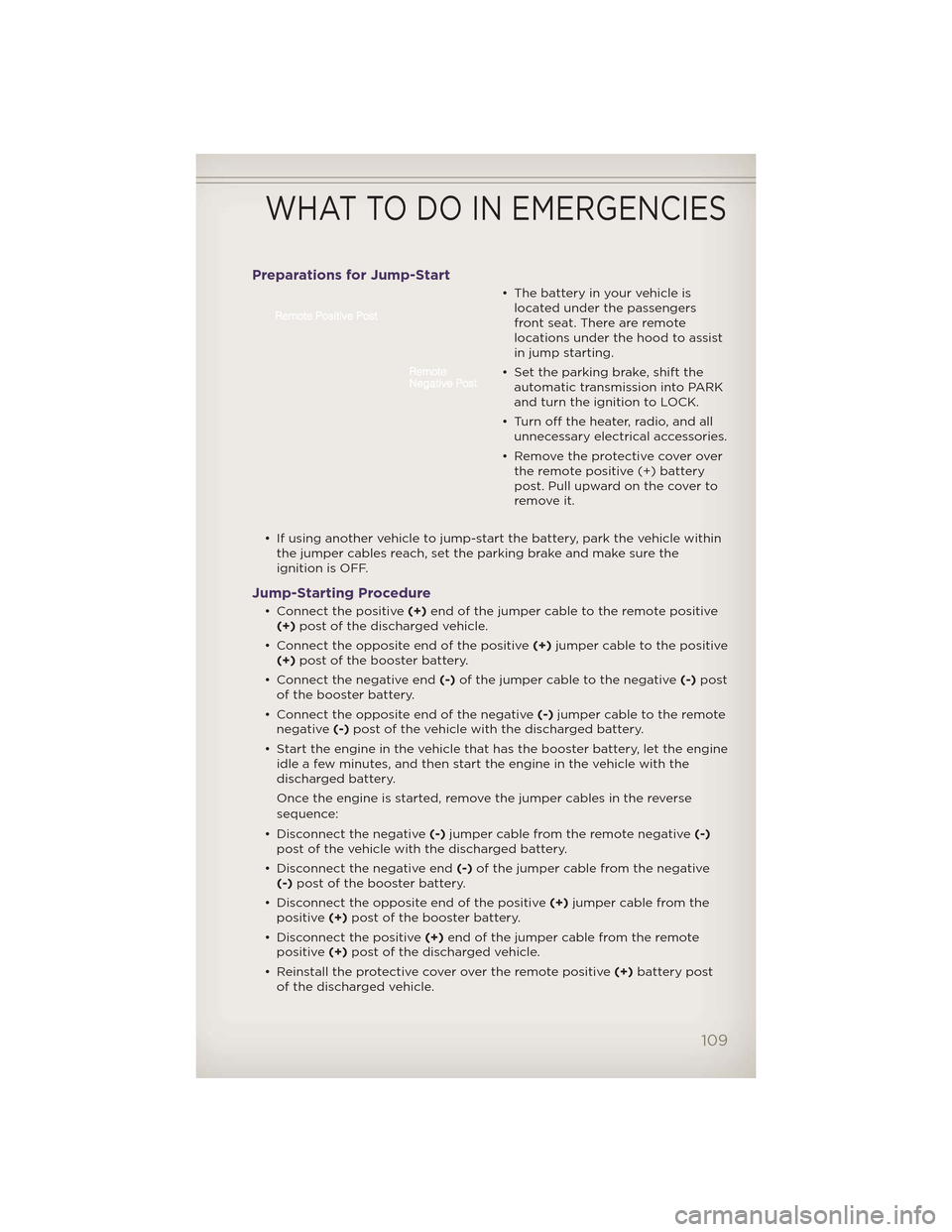
Preparations for Jump-Start
• The battery in your vehicle islocated under the passengers
front seat. There are remote
locations under the hood to assist
in jump starting.
• Set the parking brake, shift the automatic transmission into PARK
and turn the ignition to LOCK.
• Turn off the heater, radio, and all unnecessary electrical accessories.
• Remove the protective cover over the remote positive (+) battery
post. Pull upward on the cover to
remove it.
• If using another vehicle to jump-start the battery, park the vehicle within the jumper cables reach, set the parking brake and make sure the
ignition is OFF.
Jump-Starting Procedure
• Connect the positive (+)end of the jumper cable to the remote positive
(+) post of the discharged vehicle.
• Connect the opposite end of the positive (+)jumper cable to the positive
(+) post of the booster battery.
• Connect the negative end (-)of the jumper cable to the negative (-)post
of the booster battery.
• Connect the opposite end of the negative (-)jumper cable to the remote
negative (-)post of the vehicle with the discharged battery.
• Start the engine in the vehicle that has the booster battery, let the engine idle a few minutes, and then start the engine in the vehicle with the
discharged battery.
Once the engine is started, remove the jumper cables in the reverse
sequence:
• Disconnect the negative (-)jumper cable from the remote negative (-)
post of the vehicle with the discharged battery.
• Disconnect the negative end (-)of the jumper cable from the negative
(-) post of the booster battery.
• Disconnect the opposite end of the positive (+)jumper cable from the
positive (+)post of the booster battery.
• Disconnect the positive (+)end of the jumper cable from the remote
positive (+)post of the discharged vehicle.
• Reinstall the protective cover over the remote positive (+)battery post
of the discharged vehicle.
WHAT TO DO IN EMERGENCIES
109
Page 112 of 148
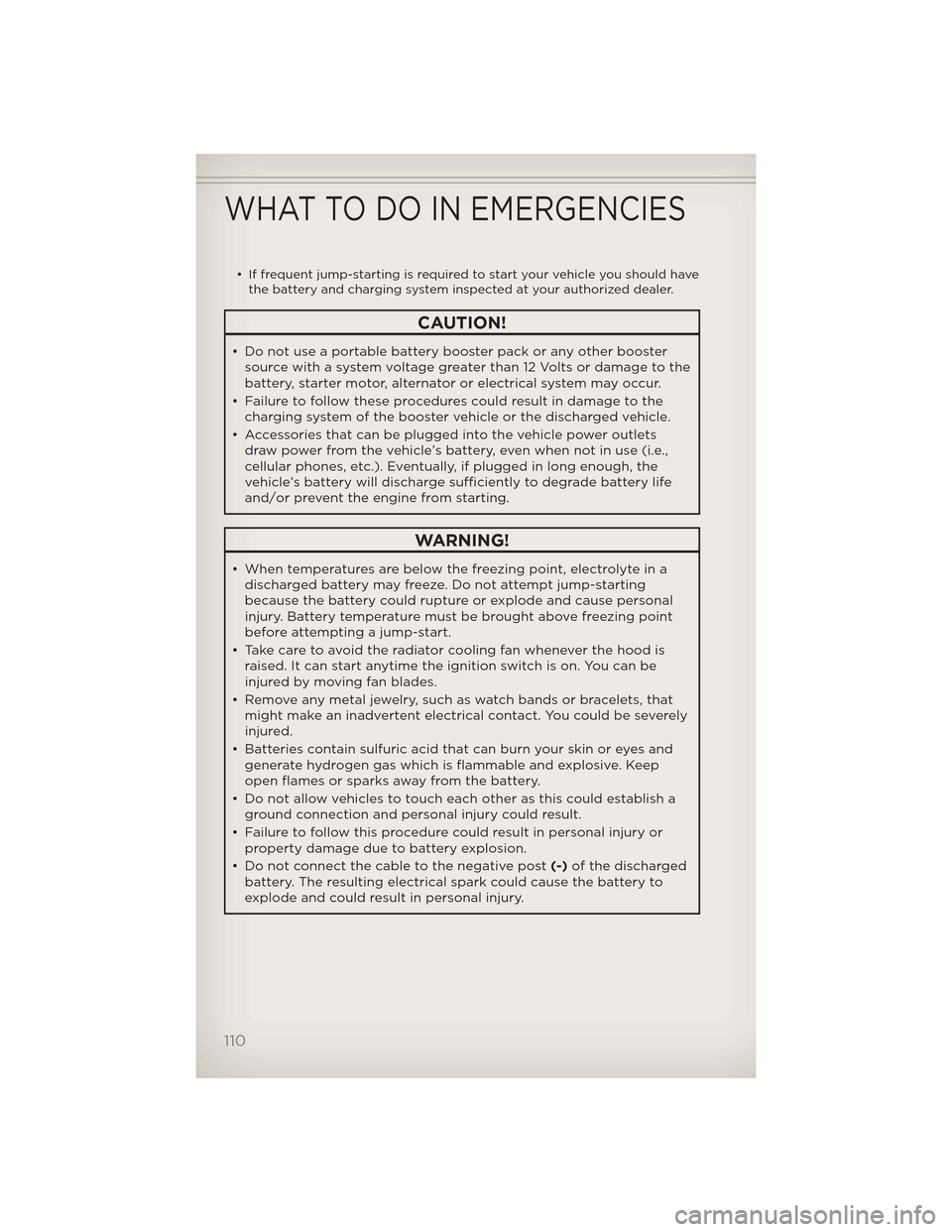
• If frequent jump-starting is required to start your vehicle you should havethe battery and charging system inspected at your authorized dealer.
CAUTION!
• Do not use a portable battery booster pack or any other boostersource with a system voltage greater than 12 Volts or damage to the
battery, starter motor, alternator or electrical system may occur.
• Failure to follow these procedures could result in damage to the charging system of the booster vehicle or the discharged vehicle.
• Accessories that can be plugged into the vehicle power outlets draw power from the vehicle’s battery, even when not in use (i.e.,
cellular phones, etc.). Eventually, if plugged in long enough, the
vehicle’s battery will discharge sufficiently to degrade battery life
and/or prevent the engine from starting.
WARNING!
• When temperatures are below the freezing point, electrolyte in adischarged battery may freeze. Do not attempt jump-starting
because the battery could rupture or explode and cause personal
injury. Battery temperature must be brought above freezing point
before attempting a jump-start.
• Take care to avoid the radiator cooling fan whenever the hood is raised. It can start anytime the ignition switch is on. You can be
injured by moving fan blades.
• Remove any metal jewelry, such as watch bands or bracelets, that might make an inadvertent electrical contact. You could be severely
injured.
• Batteries contain sulfuric acid that can burn your skin or eyes and generate hydrogen gas which is flammable and explosive. Keep
open flames or sparks away from the battery.
• Do not allow vehicles to touch each other as this could establish a ground connection and personal injury could result.
• Failure to follow this procedure could result in personal injury or property damage due to battery explosion.
• Do not connect the cable to the negative post (-)of the discharged
battery. The resulting electrical spark could cause the battery to
explode and could result in personal injury.
WHAT TO DO IN EMERGENCIES
110
Page 113 of 148
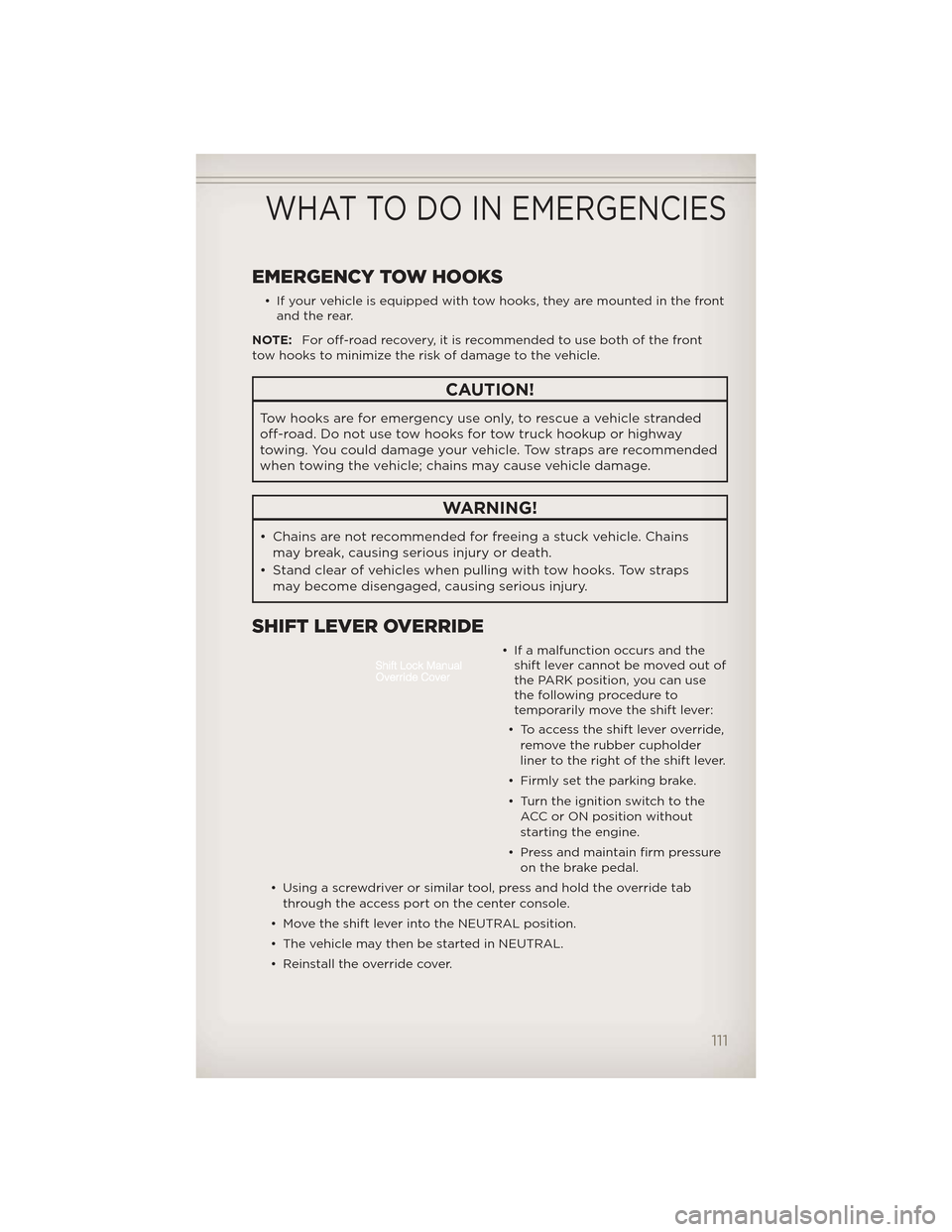
EMERGENCY TOW HOOKS
• If your vehicle is equipped with tow hooks, they are mounted in the frontand the rear.
NOTE: For off-road recovery, it is recommended to use both of the front
tow hooks to minimize the risk of damage to the vehicle.
CAUTION!
Tow hooks are for emergency use only, to rescue a vehicle stranded
off-road. Do not use tow hooks for tow truck hookup or highway
towing. You could damage your vehicle. Tow straps are recommended
when towing the vehicle; chains may cause vehicle damage.
WARNING!
• Chains are not recommended for freeing a stuck vehicle. Chains may break, causing serious injury or death.
• Stand clear of vehicles when pulling with tow hooks. Tow straps may become disengaged, causing serious injury.
SHIFT LEVER OVERRIDE
• If a malfunction occurs and theshift lever cannot be moved out of
the PARK position, you can use
the following procedure to
temporarily move the shift lever:
• To access the shift lever override, remove the rubber cupholder
liner to the right of the shift lever.
• Firmly set the parking brake.
• Turn the ignition switch to the ACC or ON position without
starting the engine.
• Press and maintain firm pressure on the brake pedal.
• Using a screwdriver or similar tool, press and hold the override tab through the access port on the center console.
• Move the shift lever into the NEUTRAL position.
• The vehicle may then be started in NEUTRAL.
• Reinstall the override cover.
WHAT TO DO IN EMERGENCIES
111
Page 114 of 148

TOWING A DISABLED VEHICLETowing ConditionWheels OFF
the Ground 2WD Models 4WD Models
Flat Tow NONE• Trans in
NEUTRAL
• 30 mph max(48 km/h)
• 15 miles (24 km) max
distance • Trans in
PARK
• T/case in NEUTRAL
•Towin forwarddirection
Wheel Lift or Dolly To w Front
NO
Rear OK
NO
Flatbed ALL BEST METHOD BEST METHOD
WHAT TO DO IN EMERGENCIES
112
Page 115 of 148
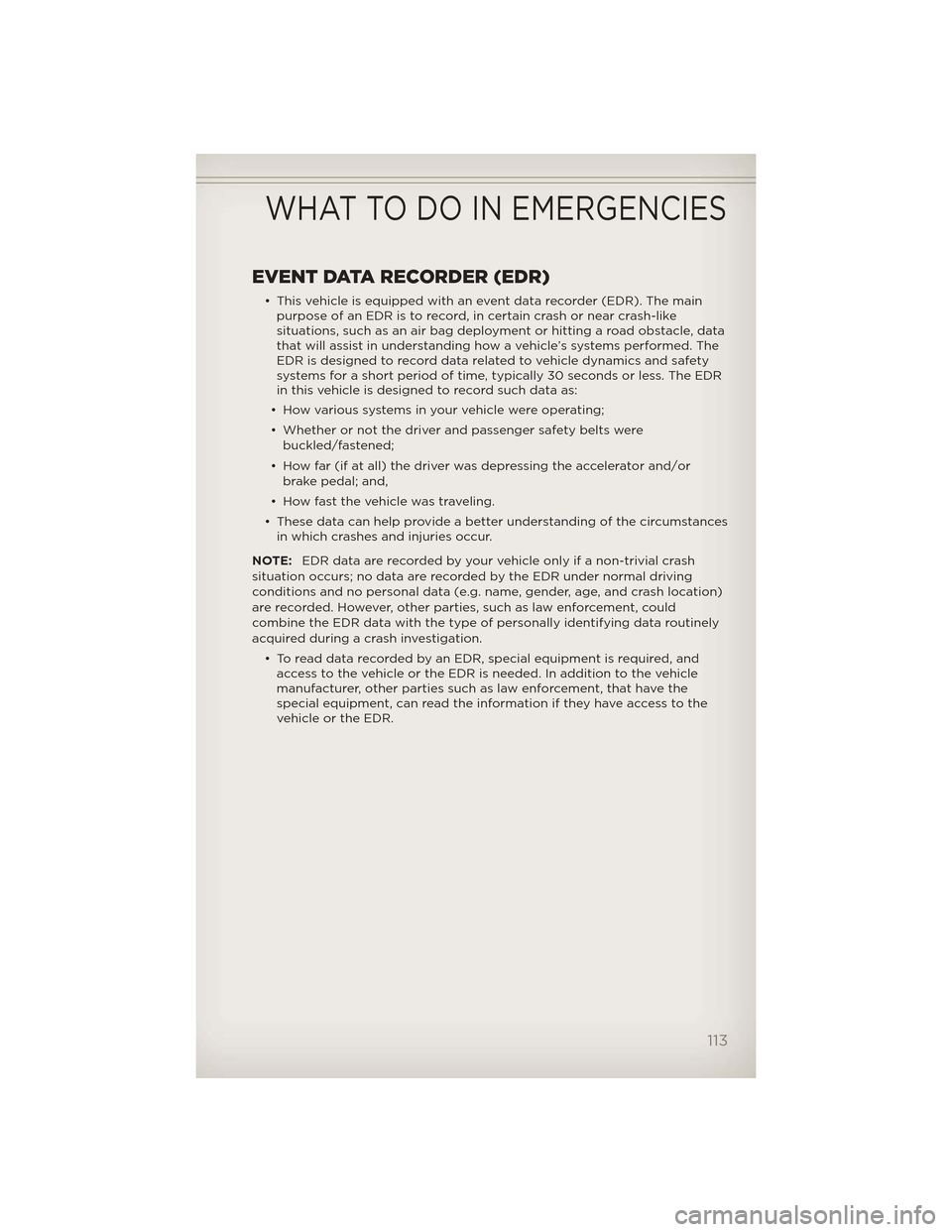
EVENT DATA RECORDER (EDR)
• This vehicle is equipped with an event data recorder (EDR). The mainpurpose of an EDR is to record, in certain crash or near crash-like
situations, such as an air bag deployment or hitting a road obstacle, data
that will assist in understanding how a vehicle’s systems performed. The
EDR is designed to record data related to vehicle dynamics and safety
systems for a short period of time, typically 30 seconds or less. The EDR
in this vehicle is designed to record such data as:
• How various systems in your vehicle were operating;
• Whether or not the driver and passenger safety belts were buckled/fastened;
• How far (if at all) the driver was depressing the accelerator and/or brake pedal; and,
• How fast the vehicle was traveling.
• These data can help provide a better understanding of the circumstances in which crashes and injuries occur.
NOTE: EDR data are recorded by your vehicle only if a non-trivial crash
situation occurs; no data are recorded by the EDR under normal driving
conditions and no personal data (e.g. name, gender, age, and crash location)
are recorded. However, other pa rties, such as law enforcement, could
combine the EDR data with the type of personally identifying data routinely
acquired during a crash investigation.
• To read data recorded by an EDR, special equipment is required, andaccess to the vehicle or the EDR is needed. In addition to the vehicle
manufacturer, other parties such as law enforcement, that have the
special equipment, can read the information if they have access to the
vehicle or the EDR.
WHAT TO DO IN EMERGENCIES
113
Page 116 of 148
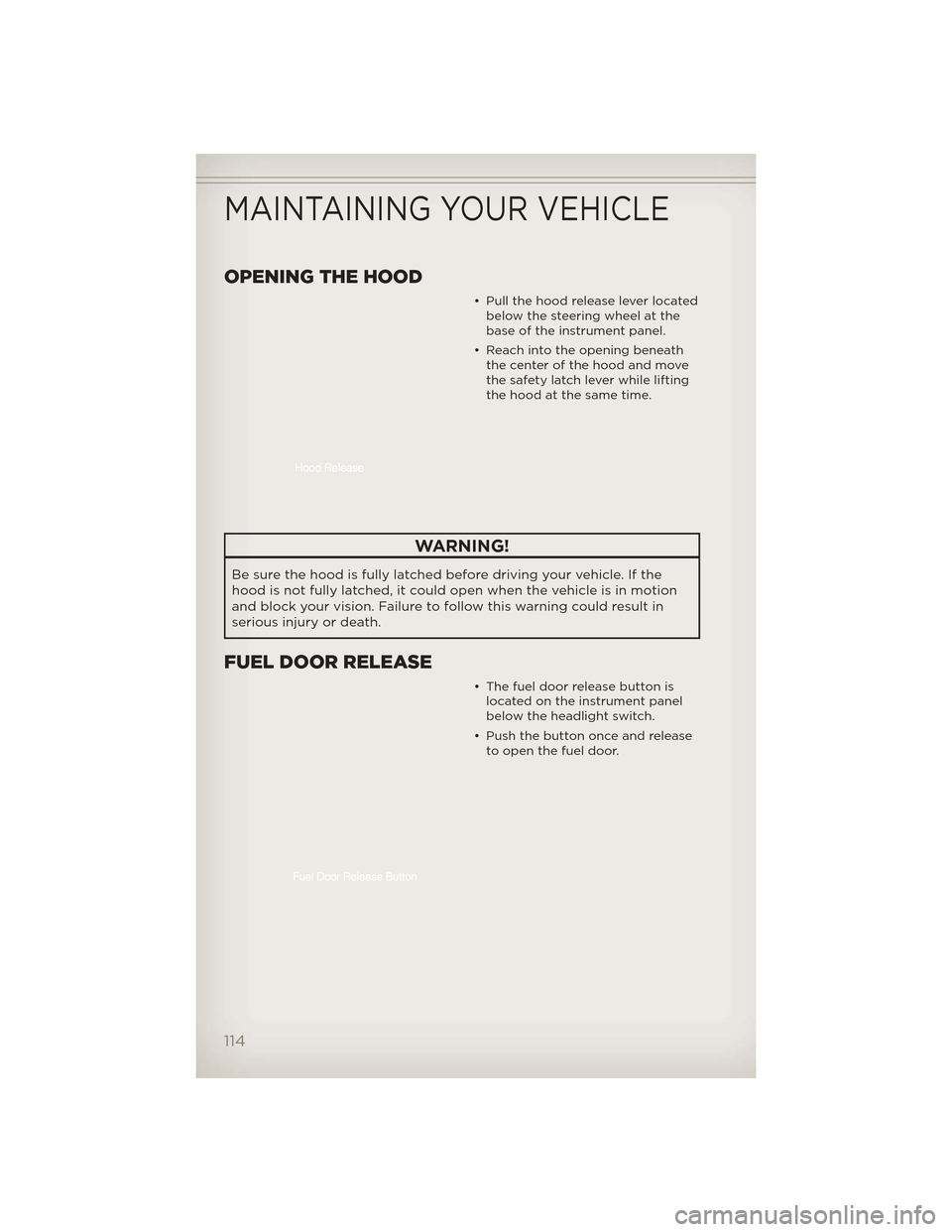
OPENING THE HOOD
• Pull the hood release lever locatedbelow the steering wheel at the
base of the instrument panel.
• Reach into the opening beneath the center of the hood and move
the safety latch lever while lifting
the hood at the same time.
WARNING!
Be sure the hood is fully latched before driving your vehicle. If the
hood is not fully latched, it could open when the vehicle is in motion
and block your vision. Failure to follow this warning could result in
serious injury or death.
FUEL DOOR RELEASE
• The fuel door release button islocated on the instrument panel
below the headlight switch.
• Push the button once and release to open the fuel door.
MAINTAINING YOUR VEHICLE
114
Page 117 of 148
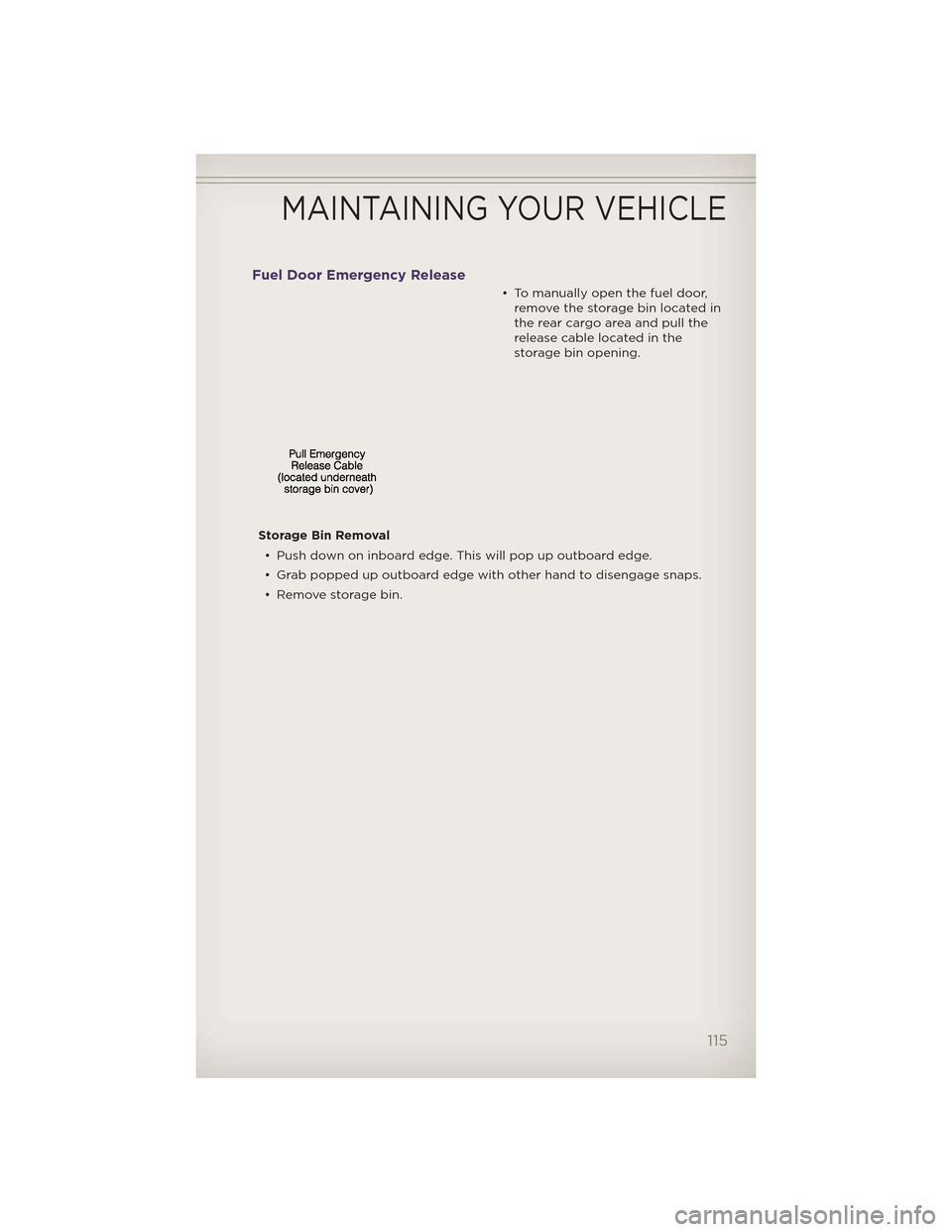
Fuel Door Emergency Release
• To manually open the fuel door,remove the storage bin located in
the rear cargo area and pull the
release cable located in the
storage bin opening.
Storage Bin Removal • Push down on inboard edge. This will pop up outboard edge.
• Grab popped up outboard edge with other hand to disengage snaps.
• Remove storage bin.
MAINTAINING YOUR VEHICLE
115
Page 118 of 148

ENGINE COMPARTMENT3.6L ENGINE
MAINTAINING YOUR VEHICLE
116
Page 119 of 148
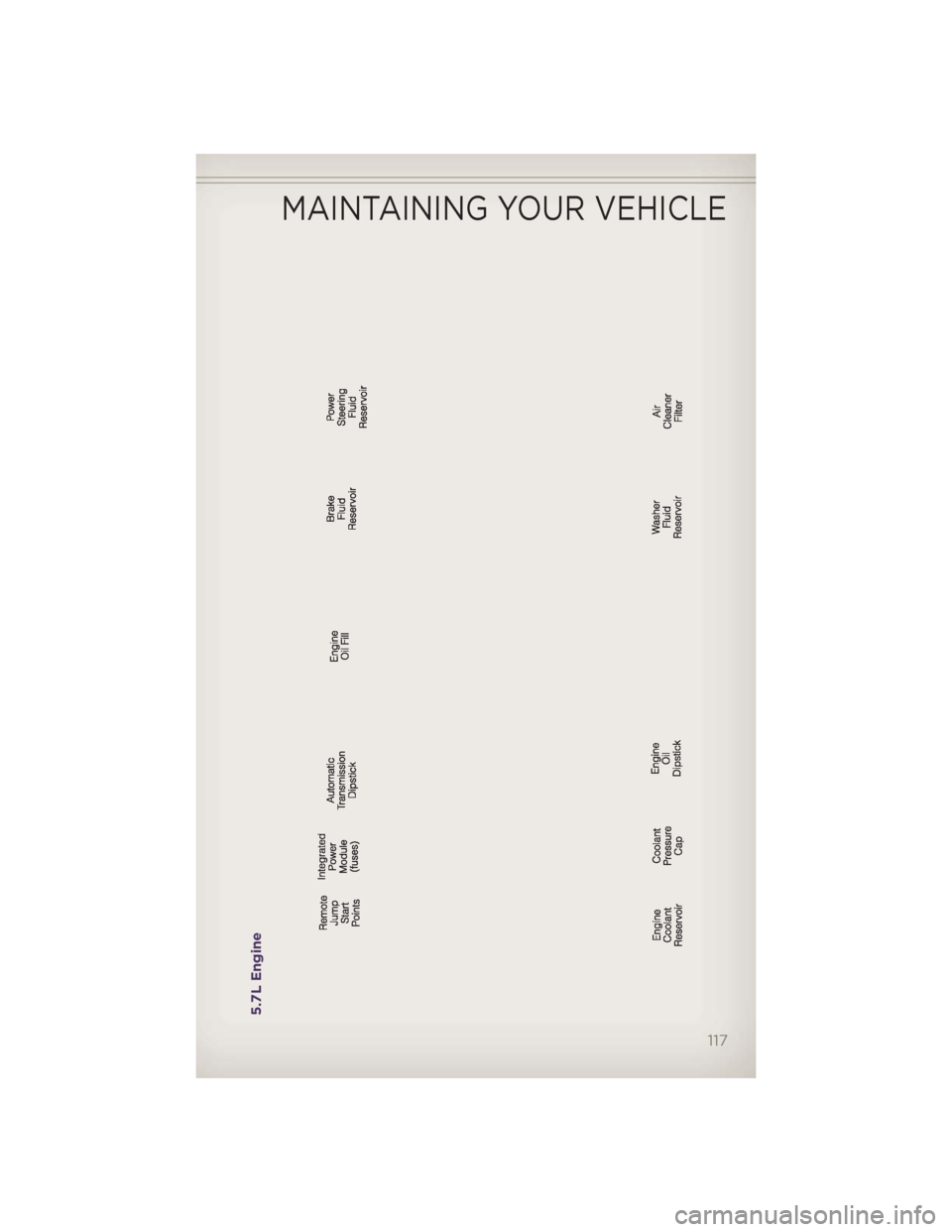
5.7L Engine
MAINTAINING YOUR VEHICLE
117
Page 120 of 148
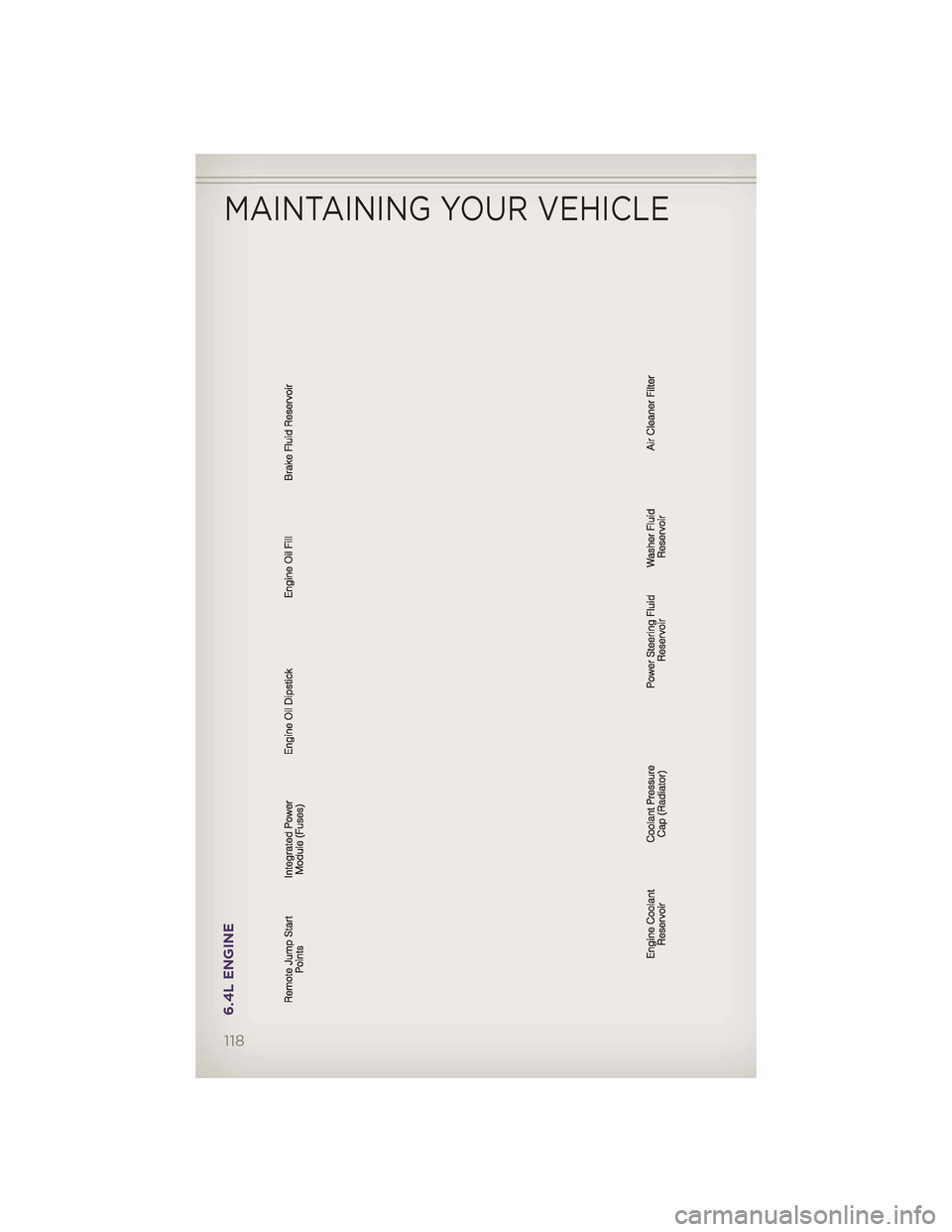
6.4L ENGINE
MAINTAINING YOUR VEHICLE
118